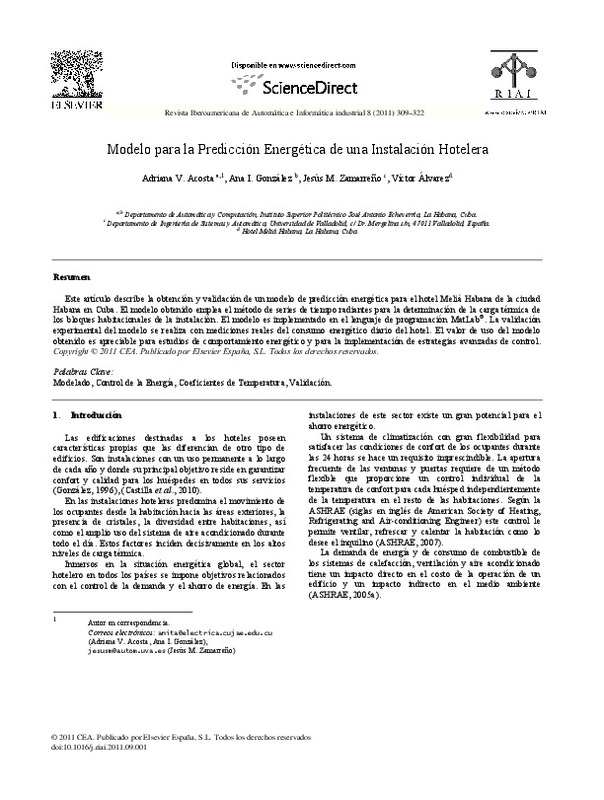Acosta CA, González A. I., 2007. Primera aproximación a un modelo de predicciones energéticas de habitación hotelera. Simposio CIE 2007. Santa Clara, Cuba.
Acosta C.A., A.I. González and V. Castelló, 2008a. Obtención de un modelo de predicciones energéticas de habitación hotelera. Conferencia FIE2008. Santiago de Cuba, Cuba.
ASHRAE, 1997. ASHRAE Handbook. Chapter 28, Nonresidential cooling and heating load calculation procedures. ASHRAE Handbook Editor.
[+]
Acosta CA, González A. I., 2007. Primera aproximación a un modelo de predicciones energéticas de habitación hotelera. Simposio CIE 2007. Santa Clara, Cuba.
Acosta C.A., A.I. González and V. Castelló, 2008a. Obtención de un modelo de predicciones energéticas de habitación hotelera. Conferencia FIE2008. Santiago de Cuba, Cuba.
ASHRAE, 1997. ASHRAE Handbook. Chapter 28, Nonresidential cooling and heating load calculation procedures. ASHRAE Handbook Editor.
ASHRAE, 2005a. ASHRAE Handbook. Chapter 30, Nonresidential cooling and heating load calculation procedures. ASHRAE Handbook Editor.
ASHRAE, 2005b ASHRAE Handbook. Chapter 32, Energy Estimating and modeling methods. ASHRAE Handbook Editor.
ASHRAE. 2007. ASHRAE Handbook. Chapter 5, Hotels, Motels, and Dormitories. ASHRAE Handbook Editor.
ASHRAE. 2009. ASHRAE Handbook. Chapter 15, Fenestration. ASHRAE Handbook Editor.
Budaiwi I.M,. 2003. Air conditioning system operation strategies for intermittent occupancy building in a hot -sumid climate. King Fahd University of petroleum and minerals architectural, Engineering Department. Proceedings: Building Simulation 2007.
Castilla, M., Álvarez, J. D., Berenguel, M., Pérez, M., Rodríguez, F., & Guzmán, J. L. (2010). Técnicas de Control del Confort en Edificios. Revista Iberoamericana de Automática e Informática Industrial RIAI, 7(3), 5-24. doi:10.1016/s1697-7912(10)70038-8
Crawley, D. B., Lawrie, L. K., Winkelmann, F. C., Buhl, W. F., Huang, Y. J., Pedersen, C. O., … Glazer, J. (2001). EnergyPlus: creating a new-generation building energy simulation program. Energy and Buildings, 33(4), 319-331. doi:10.1016/s0378-7788(00)00114-6
Li, D. H. W., Lam, T. N. T., Chan, W. W. H., & Mak, A. H. L. (2009). Energy and cost analysis of semi-transparent photovoltaic in office buildings. Applied Energy, 86(5), 722-729. doi:10.1016/j.apenergy.2008.08.009
Gugliermetti, F., Passerini, G., & Bisegna, F. (2004). Climate models for the assessment of office buildings energy performance. Building and Environment, 39(1), 39-50. doi:10.1016/s0360-1323(03)00138-0
Fumio Sakurai, Dr. Tatsuo Inooka, Dr. Ryuji Yanagihara, Etsuo Higashizawa, Junya Hamane, Tatsuo Fujii, Hisashi Nishihata, Hideto Hayashi, Fumihiro Arizumi, Hiroshi Ninomiya, Kazusa Koike and Naoko Shinohara, 2007. FACES (Forecast of air-conditioning system's energy, environmental, and economical, performance by simulation). Proceedings: Building Simulation 2007. Japan.
González Santos AI. 1996. Sistema de regulación automático para controlar el índice de confort en ambientes climatizados. Tesis de Maestría en Automática, ISPJAE. Cuba.
Ip Seng Iu., 2002. Experimental validation of the radiant time series method for cooling load calculations. Thesis of the Degree of Master of Science. Oklahoma State University.
Iu, Pisen Calvin, 2004. PRF/RTF Generator Software. www.hvac.okstate.edu.
Aktacir, M. A., Büyükalaca, O., Bulut, H., & Yılmaz, T. (2008). Influence of different outdoor design conditions on design cooling load and design capacities of air conditioning equipments. Energy Conversion and Management, 49(6), 1766-1773. doi:10.1016/j.enconman.2007.10.021
MathWorks, 2007. Matlab 7.4.0. Ayuda de la herramienta, versión 7.0.
McQuiston, F.C. and J.D. Spitler, 1992. Cooling and heating load calculation manual. 2nd ed. ASHRAE.
Mingxian Cui and Tingyao Chen, 2009. A revised radiant time series (RTS) method for intermittent cooling load calculation Eleventh International IBPSA Conference. Glasgow, Scotland.
Botsaris, P. N., & Prebezanos, S. (2004). A methodology for a thermal energy building audit. Building and Environment, 39(2), 195-199. doi:10.1016/j.buildenv.2003.08.016
Pedrini, A., Westphal, F. S., & Lamberts, R. (2002). A methodology for building energy modelling and calibration in warm climates. Building and Environment, 37(8-9), 903-912. doi:10.1016/s0360-1323(02)00051-3
Chirarattananon, S., & Taveekun, J. (2004). An OTTV-based energy estimation model for commercial buildings in Thailand. Energy and Buildings, 36(7), 680-689. doi:10.1016/j.enbuild.2004.01.035
Chen, T., & Cui, M. (2010). A RTS-based method for direct and consistent calculating intermittent peak cooling loads. Energy Conversion and Management, 51(6), 1170-1178. doi:10.1016/j.enconman.2009.12.027
Trott A. R. and Welch T, 2000. Refrigeration and air-conditioning. Third edition by Butterworth-Heinemann.
U.S. Army, 1979. BLAST, the building loads analysis and system thermodynamics program—Users manual. U.S. Army Construction Engineering Research Laboratory Report E-153.l.
US Department of Energy, 2005. ENERGYPLUSTM, Input Output Reference.
Yik, F. W. H., Burnett, J., & Prescott, I. (2001). Predicting air-conditioning energy consumption of a group of buildings using different heat rejection methods. Energy and Buildings, 33(2), 151-166. doi:10.1016/s0378-7788(00)00094-3
York D.A. and C.C. Cappiello, eds, 1982. DOE-2 engineers manual. Lawrence Berkeley Laboratory Report LBL-11353 (LA-8520-M, DE83004575). National Technical Information Services, Springfield, VA.
[-]








